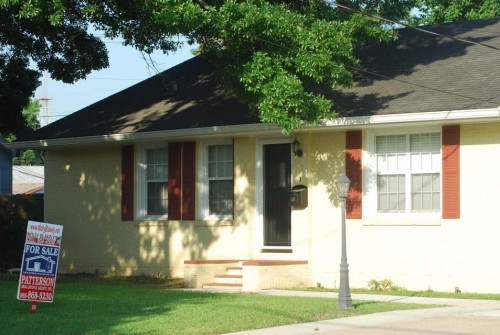
Cleveland Verdin
May 26, 2008
Dr. Charles "Chuck" Binford
May 28, 2008The number of homes sold in the Tri-parishes has fallen this year, following the national trend, but the decline comes after a post-Katrina boom in house sales, say most local real estate agents.
“It’s more of a normal market,” said Bill Boyd, a broker with Houma’s Town & Country Real Estate, the Tri-parishes’ top real estate agency by sales volume. “We’ve had an inflated market since Katrina. We’ve been blessed with a strong, oil-based economy, but we’re not bulletproof.”
“In Thibodaux and Houma, there was an overabundance of new homes we were building,” said Linda Verzwyvelt , a broker with New Horizons Realty in Thibodaux.
Nationally, house prices have fallen substantially. A recent issue of Money magazine states home prices are expected to fall 12.7 percent in the country’s 20 largest housing markets through this February.
However, home prices in the Tri-parishes have been running counter to national trends, according to local real estate agents. “Market values have not dropped,” said Shirin Nail with RE/MAX Good Earth Realty in Houma, pointing to a home that sold for $119,000 two years ago went for $145,000 recently.
Verzwyvelt said new homes are selling for a minimum of $170,000, compared to 10 to 15 years ago, when prices were at $90,000.
“Anything under $130,000 is very marketable,” said Karen Daroca, an agent with New Horizons. “Anything over $200,000 would have to be exceptional.”
But even $200,000 to $250,000 homes “are moving pretty fast,” Nail said. “Any homes under $200,000 tend to sell faster because there’s a bigger pool of buyers,” she said.
Houses in the $300,000 to $350,000 range are moving slower.
Homes in East Houma are selling unusually fast, Nail said. Sales on the east side typically are slower than those in West Houma, though sales on the west side have been strong too, she said.
“We need homes for sale,” she said, “a lot of homes.”
Daniel Sons, a broker with Bayouland Realty in Morgan City, had a contrasting view about home prices.
“The market’s averaging out like it was before Katrina,” Sons said. “People are taking $15,000 to $20,000 less money. There are more homes on the market. It’s more of a buyer’s market.”
Sons said people are purchasing existing homes and constructing fewer new ones.
New-home construction is costing $125 a square foot, he said.
“Who can afford to buy them?” he said. “The cost to build a new home is outrageous.”
People are fixing up older homes to sell, he said.
“You can buy more square footage with an existing home,” said Boyd, who served as chairman of the Louisiana Real Estate Commission last year. “The trade-off is that you’re not getting a brand-new home.”
“We’re fortunate to be in the Houma-Thibodaux area,” he said. “We’re in good shape.”
That is not the case for the rest of the country. To invigorate the nation’s slowing economy, the Federal Reserve has lowered interest rates, causing a homebuyer rush toward refinancing mortgages.
“The mortgage industry is hurting,” Daroca said. “Lenders are tightening their purse strings.”
Lois Cedotal, with Cedotal Mortgage in Thibodaux, said that in 2008, 75 percent of the company’s business has been refinancing and the remainder has been new mortgage purchases. Post-Katrina – from 2005 through 2007, the numbers were reversed.
“It’s not a buyer’s market (for mortgages),” she said. “It’s a refinance market. People are still buying, but it’s more refinances.”
Demand for mortgages began to slow late last year, mostly because of the crisis in the subprime loan market, said mortgage originator Kimberly Politz with FBT Mortgage, which recently opened an office in Houma.
Politz said half her office’s business has consisted of refinancing. She anticipates greater demand for refinancing as interest rates decline.
Mortgage lenders are requiring higher down payments, too. Homebuyers typically need to put five percent down.
“It’s more difficult to get approved for home loans,” Politz said.
Her office stopped offering 100 percent financing around January. Ninety-seven percent financing has been largely eliminated as well, except for federally-backed home loans and instances where the home seller pays closing costs.
“If you search, you may be able to find 100 percent financing, but the interest rates would be astronomical,” Daroca said.
Cedotal said homebuyers need a 620 score (350 is low and 850 is high) to acquire 97 percent financing. She said a good credit rating can bring a homebuyer a five to six percent interest rate; a mediocre rating, six to seven percent.
When refinancing, homebuyers are bundling first and second mortgages together. Cedotal said many companies are not even offering second mortgages anymore.
“Interest rates are lower,” she said. “We recommend people refinance.”
On top of the credit crunch, homebuyers are confronting property insurance rates high enough to put home ownership financially out of reach for some.
“They know they need to purchase insurance to purchase a house,” Daroca said.
“We try to give them an estimate so they can know whether they can afford the house and the insurance,” she added.
Still, even though purchasing a home may require two incomes, interest rates are still low, Verzwyvelt said.
“If you need a house,” she said, “we can find you one.”
Low- to middle-priced homes are in high demand, area Realtors say. Homes in the $300,000 price range are slower to sell in today’s market. * Photo by KEYON JEFF














